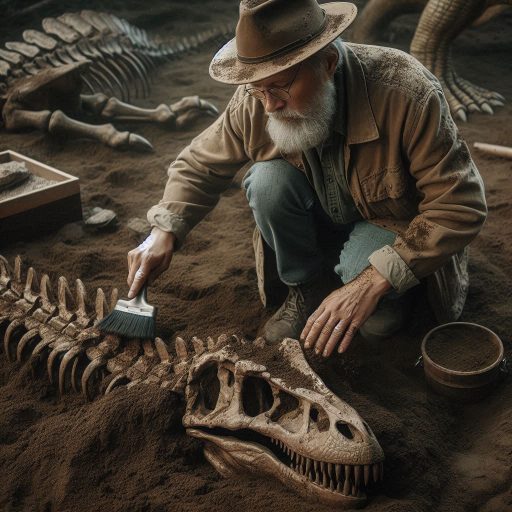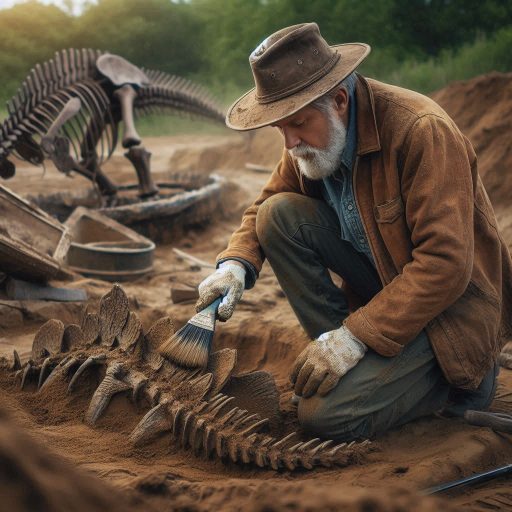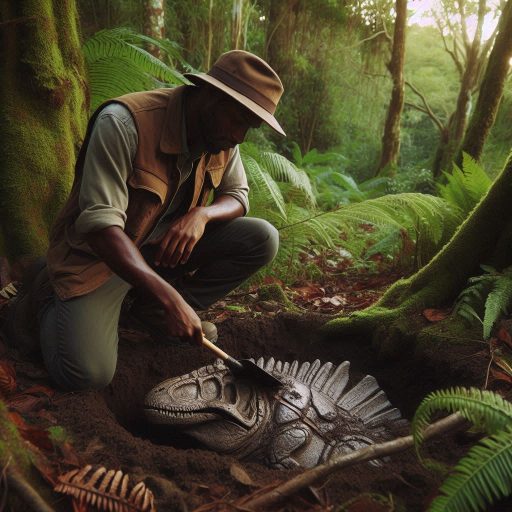Introduction
Paleontology is the study of ancient life through fossils and geological records.
This field helps us understand the history of life on Earth.
By analyzing fossils, paleontologists uncover the evolution of species over millions of years.
Their work provides insights into how life has adapted to changing environments.
Paleontologists play a crucial role in revealing Earth‘s past.
They investigate the characteristics of ancient organisms and their ecosystems.
Their findings illuminate the connections between extinct species and modern-day organisms.
These connections help us understand evolutionary processes and biodiversity.
Famous paleontologists, like Mary Anning and Richard Owen, made significant contributions to the field.
Anning‘s discoveries in the Jurassic marine fossil beds transformed our understanding of prehistoric life.
Owen famously described the first dinosaur fossils, shaping the field’s future.
These scientists not only discover fossils but also contextualize them within Earth’s history.
Their research sheds light on extinction events, climate changes, and mass migrations.
Understanding these factors helps us grasp how life evolves and adapts.
In summary, paleontologists are vital to understanding Earth’s history and evolution.
Their groundbreaking discoveries deepen our knowledge of life‘s complexity and resilience throughout time.
Their work inspires future generations of scientists to explore Earth‘s ancient past.
Mary Anning
Background Information on Mary Anning
Mary Anning was a pioneering paleontologist born in 1799 in Lyme Regis, England.
She came from a modest background and faced numerous challenges.
Her father, a fossil collector, died when she was just 11 years old.
After his death, Mary and her family struggled financially.
To support her family, she began collecting and selling fossils along the Jurassic Coast.
Mary quickly gained recognition for her keen eye and extensive knowledge of fossils.
She spent long hours searching for specimens on the rocky shore.
Her dedication and passion for paleontology were unmatched.
Despite her lack of formal education, she became a respected figure in the scientific community.
Many prominent scientists of her time sought her insights and expertise.
Mary’s work laid the foundation for many future paleontologists.
She made significant contributions to the understanding of prehistoric life.
Her story is one of perseverance and innovation, inspiring generations of scientists.
Discovery of the First Complete Ichthyosaur Skeleton
One of Mary Anning’s most significant achievements was the discovery of the first complete Ichthyosaur skeleton in 1811.
This marine reptile lived during the early Jurassic period, about 200 million years ago.
The skeleton measured over 10 feet long and included nearly every bone.
Anning’s discovery was groundbreaking, as it provided valuable insight into the anatomy of these ancient creatures.
She unearthed the skeleton near Lyme Regis, where she often collected fossils.
Anning meticulously excavated the specimen, demonstrating her skill and expertise.
This find attracted attention from scientists and collectors alike.
It confirmed that large reptiles once roamed the oceans, altering the prevailing theories about prehistoric life.
Her discovery opened new avenues of research for paleontologists.
Scientists began to explore the relationships between different species of marine reptiles.
Anning’s work also contributed to the understanding of vertebrate evolution.
Her contributions continue to resonate in modern paleontological studies.
Impact of Her Work on the Field of Paleontology
Mary Anning’s work significantly impacted the field of paleontology.
Her discoveries helped establish the importance of fossils in understanding Earth’s history.
She became a trailblazer for women in science, paving the way for future generations.
Despite facing societal challenges, she demonstrated that dedication and hard work can yield extraordinary results.
Anning’s meticulous documentation of her finds laid the groundwork for scientific rigor in paleontology.
She inspired other scientists to adopt similar methods.
Her contributions led to a shift in how paleontologists approached their research.
Mary Anning also influenced the study of extinction.
Her findings supported the idea that species could disappear from the Earth.
This concept revolutionized the understanding of life and extinction events.
Her work helped shape modern paleontology and sparked further investigations into prehistoric ecosystems.
Mary Anning’s groundbreaking discoveries changed the course of paleontology.
Her passion and perseverance continue to inspire scientists today.
She remains an enduring symbol of resilience and a pioneer in her field.
Her legacy is a testament to the importance of curiosity and dedication in scientific exploration.
Robert Bakker
Background Information on Robert Bakker
Robert Bakker was born on March 24, 1938, in New York City.
He developed an interest in dinosaurs at a young age.
After earning a degree in geology from Colorado College, he pursued graduate studies in paleontology at Yale University.
Bakker’s academic journey allowed him to study under influential paleontologists.
His passion for dinosaurs drove him to explore uncharted territories in the field.
In the 1960s, Bakker gained recognition for his bold theories about dinosaurs.
He published numerous articles and books that challenged traditional views.
His work sparked debates within the scientific community and inspired a new generation of paleontologists.
Bakker’s ideas often clashed with the prevailing notions of the time, leading to groundbreaking discussions about dinosaur biology.
Contributions to the Understanding of Dinosaur Behavior
One of Bakker’s major contributions involves understanding dinosaur behavior.
He argued that many dinosaurs were more active than previously thought.
Traditional views depicted dinosaurs as slow, lumbering reptiles.
Bakker’s research suggested that some species exhibited behaviors similar to modern birds.
He examined the skeletal structure of various dinosaurs, noting adaptations for speed and agility.
Bakker also studied dinosaur trackways, which provided insights into their locomotion.
His findings indicated that some dinosaurs lived in herds, demonstrating social behaviors.
This perspective shifted the narrative about dinosaurs, revealing them as dynamic and social creatures.
Bakker’s work helped bridge the gap between reptiles and birds.
He emphasized that dinosaurs shared many characteristics with modern birds, such as nesting and parenting behaviors.
This connection between dinosaurs and birds changed how scientists viewed the evolutionary history of these species.
Development of the Theory of Warm-Blooded Dinosaurs
Perhaps Bakker’s most revolutionary idea involves the concept of warm-blooded dinosaurs.
Before his research, most scientists believed dinosaurs were cold-blooded.
Bakker challenged this idea, proposing that some dinosaurs were endothermic, or warm-blooded.
He supported this theory by examining their physical characteristics.
Bakker pointed to features such as bone structure, which suggested a higher metabolic rate.
He argued that warm-bloodedness would allow dinosaurs to be more active and adaptable to their environments.
This theory opened new avenues for research into dinosaur physiology and ecology.
His ideas also sparked discussions about the evolutionary advantages of warm-bloodedness.
If dinosaurs were warm-blooded, it would explain their dominance in various ecosystems during the Mesozoic Era.
Bakker’s theories encouraged paleontologists to re-evaluate the adaptations and behaviors of these ancient creatures.
Robert Bakker’s groundbreaking work has transformed our understanding of dinosaurs.
His insights into dinosaur behavior and the theory of warm-bloodedness have reshaped paleontological research.
By challenging established norms, Bakker has inspired countless scientists to explore the complexities of dinosaur life.
His legacy continues to influence paleontology and fuel the quest for knowledge about our planet’s prehistoric past.
Read: Top Chemistry Departments and Schools in the US
Sue Hendrickson
Background Information on Sue Hendrickson
Sue Hendrickson is a prominent paleontologist known for her remarkable contributions to the field.
She was born in 1960 in Chicago, Illinois.
Hendrickson developed a passion for fossils at a young age.
She often explored the natural world, collecting rocks and bones as a child.
Hendrickson pursued her education in geology and paleontology.
She earned a degree in geology from the University of Illinois.
After completing her studies, she worked as a fossil hunter and field researcher.
Her hands-on experience in the field set her apart from her peers.
In the late 1980s, she became involved in several fossil excavation projects.
These experiences allowed her to hone her skills in identifying and recovering fossils.
Her dedication to paleontology eventually led her to one of the most significant discoveries in the field.
Discovery of the Largest and Most Complete T. Rex Skeleton
In 1990, Hendrickson made a groundbreaking discovery in South Dakota.
While working for the Black Hills Institute of Geological Research, she stumbled upon a fossil site.
This site contained the remains of a Tyrannosaurus rex skeleton, later named ‘Sue‘.
The discovery of Sue was monumental in several ways.
First, it represented the largest and most complete T.rex skeleton ever found.
The skeleton measured over 40 feet long and was nearly 90% complete.
This level of preservation was unprecedented and provided immense insight into the species.
Hendrickson and her team meticulously excavated the skeleton over several months.
They used advanced techniques to preserve the bones during extraction.
Once excavated, Sue became a centerpiece for paleontological research.
Impact of Her Discovery on the Field of Paleontology
Sue Hendrickson‘s discovery had a profound impact on paleontology.
It significantly advanced the scientific understanding of T. rex anatomy and behavior.
Researchers gained new insights into the life history of these fascinating creatures.
The discovery also sparked increased public interest in paleontology.
Sue’s skeleton was displayed at the Field Museum in Chicago, drawing massive crowds.
This exhibit introduced millions to the world of dinosaurs, inspiring future generations of paleontologists.
Furthermore, the discovery prompted new research methodologies in fossil excavation.
Paleontologists began to adopt more systematic and careful techniques when recovering fossils.
This shift improved the preservation of specimens and enhanced the quality of scientific research.
Sue Hendrickson‘s contributions extended beyond her discovery.
She has served as a role model for women in science, encouraging young girls to pursue careers in paleontology.
Her groundbreaking work and dedication have left an indelible mark on the field.
Sue Hendrickson‘s background, the discovery of the largest T. rex skeleton, and the impact of her work on paleontology demonstrate her significance in the field.
Her legacy continues to inspire scientists and fossil enthusiasts alike.
Read: How to Become a Licensed Chemist in the USA: Steps and Tips
Jack Horner
Background Information on Jack Horner
Jack Horner is a renowned American paleontologist known for his extensive work on dinosaurs.
He was born on June 15, 1946, in Salt Lake City, Utah.
Horner developed an interest in paleontology during his childhood.
He earned his bachelor’s degree in geology from the University of Montana.
He later pursued a master’s degree in paleontology from the same institution.
Horner’s fieldwork in Montana’s badlands contributed significantly to his reputation.
He discovered numerous dinosaur fossils, which revealed insights into their lives.
He has also worked at the Museum of the Rockies, where he serves as the curator of paleontology.
Throughout his career, Horner has authored several influential books and scientific papers.
His passion for dinosaurs has inspired many students and budding paleontologists.
Discoveries Related to Dinosaur Growth and Behavior
Horner made groundbreaking discoveries regarding dinosaur growth and behavior.
He studied dinosaur nests, eggs, and juvenile fossils extensively.
His research demonstrated that some dinosaurs exhibited parental care for their young.
This finding was revolutionary, as it challenged previous assumptions about dinosaur behavior.
He discovered the first dinosaur eggs in North America, which offered new insights into reproductive habits.
By examining these fossils, Horner showed that some species, like the Maiasaura, cared for their nests.
His work on the growth patterns of dinosaurs changed the way scientists view their life cycles.
Horner also examined the impact of environmental factors on dinosaur growth.
He found that certain dinosaurs grew rapidly, indicating they adapted to changing conditions.
His research highlighted the diversity of growth strategies among different dinosaur species.
This understanding deepens our appreciation for their adaptability in ancient ecosystems.
Influence on the Portrayal of Dinosaurs in Popular Culture
Jack Horner’s influence extends beyond academia into popular culture.
He served as a scientific consultant for the “Jurassic Park” film series.
His insights helped shape the portrayal of dinosaurs in these blockbuster movies.
Horner advocated for a more accurate representation of dinosaur behavior and biology.
His work emphasized that dinosaurs were dynamic creatures, not just lumbering reptiles.
He argued for the inclusion of feathers and bird-like characteristics in dinosaur depictions.
This perspective influenced filmmakers and inspired artists to reimagine dinosaurs as vibrant and active animals.
Horner’s contributions have changed how the public views dinosaurs.
They are no longer seen as mere monsters but as complex creatures with fascinating behaviors.
His educational efforts have sparked a greater interest in paleontology among the general public.
As a result, more people appreciate the science behind these ancient beings.
Jack Horner‘s background and discoveries have reshaped our understanding of dinosaurs.
His research on dinosaur growth and behavior has revealed their adaptability and complexity.
Moreover, his influence on popular culture has transformed how we perceive these ancient creatures.
Horner‘s legacy will continue to inspire future generations of paleontologists.
Read: Biology Ethics: Navigating Complex Issues in the US

Gain More Insights: Salary Expectations for Immunologists in the USA
You Might Also Like: What Does a Seismologist Do? Career Overview
Mary Schweitzer
Background Information on Mary Schweitzer
Mary Schweitzer is a pioneering paleontologist known for her groundbreaking research.
Born in 1970, she grew up with a fascination for dinosaurs.
Schweitzer earned her Ph.D. in biology from the University of Montana.
She later became a professor at North Carolina State University.
Throughout her career, she has focused on studying dinosaur fossils and ancient life forms.
Her work has significantly impacted the field of paleontology.
Schweitzer‘s research challenges long-held assumptions about fossil preservation and the limits of ancient biological materials.
Discovery of Soft Tissues in Dinosaur Fossils
In 2005, Mary Schweitzer made a shocking discovery.
She found soft tissues in a 68-million-year-old Tyrannosaurus rex fossil.
This was the first time such preservation had been observed in a dinosaur.
Her findings included blood vessels, collagen, and even intact cells.
Initially, many scientists were skeptical about her claims.
They believed that organic materials could not survive millions of years.
Schweitzer’s meticulous research provided substantial evidence for her findings.
She utilized advanced imaging techniques and biochemical tests to analyze the samples.
Her work demonstrated that these soft tissues could indeed endure through time.
The discovery opened a new window into the biology of dinosaurs.
It suggested that some biological materials might survive under specific conditions.
This revelation challenged the prevailing belief that fossils were solely mineralized remains.
Schweitzer‘s findings ignited a wave of excitement in the scientific community.
Her work encouraged other researchers to explore the possibility of ancient biomolecules in fossils.
Transform Your Career Today
Unlock a personalized career strategy that drives real results. Get tailored advice and a roadmap designed just for you.
Start NowImplications of Her Discoveries for the Study of Ancient Life Forms
Schweitzer’s discoveries have profound implications for understanding ancient life forms.
They suggest that the biological remnants of extinct species may be more accessible than previously thought.
The ability to study soft tissues can provide insights into dinosaur biology, physiology, and behavior.
It can also shed light on the evolutionary relationships between dinosaurs and modern birds.
Her findings have opened the door to exploring the genetic material of ancient species.
Researchers are now investigating the potential to extract DNA from these soft tissues.
This has sparked discussions about the possibilities of studying extinct species on a molecular level.
Schweitzer’s research has also raised important questions about fossil preservation.
Understanding how organic materials can survive over millions of years can change paleontological methodologies.
It encourages scientists to rethink their approaches to excavating and studying fossils.
Furthermore, Schweitzer’s work highlights the need for interdisciplinary collaboration.
It integrates paleontology with molecular biology and biochemistry.
This collaboration can lead to new discoveries about the past.
Mary Schweitzer’s contributions continue to inspire paleontologists worldwide.
Her groundbreaking work encourages new generations to explore the mysteries of ancient life forms.
The excitement surrounding her discoveries illustrates the dynamic nature of paleontological research.
Read: Continuous Learning: Post-graduate Options for US Biologists
Paul Sereno
Background Information on Paul Sereno
Paul Sereno is a renowned paleontologist known for his extensive work in dinosaur research.
He was born in 1948 in Chicago, Illinois.
Sereno developed a passion for fossils at an early age.
He pursued a degree in geology and later earned a Ph.D. in evolutionary biology.
His academic journey laid the foundation for his groundbreaking discoveries.
Sereno has worked with several prominent institutions, including the University of Chicago.
He also engages in public education through lectures and documentaries.
His dynamic teaching style inspires students and the public alike.
Sereno‘s ability to communicate complex ideas makes him a leading figure in paleontology.
Discoveries of New Dinosaur Species in Africa
Sereno is best known for his remarkable discoveries of new dinosaur species in Africa.
His expeditions in the Sahara Desert have yielded significant finds.
In the 1990s, he led a team that unearthed the fossils of Spinosaurus, one of the largest carnivorous dinosaurs.
This discovery reshaped our understanding of dinosaur sizes and adaptations.
Another significant discovery was the identification of Carcharodontosaurus.
This dinosaur rivaled Tyrannosaurus rex in size and ferocity.
Sereno‘s work highlights the diversity of theropod dinosaurs that roamed ancient landscapes.
His findings help illustrate the evolutionary lineage of dinosaurs.
Sereno also contributed to the discovery of several smaller species, like Nigersaurus.
This unique dinosaur had a wide, flat skull with numerous teeth.
Its discovery shed light on the herbivorous dinosaurs that once grazed the lush vegetation of Africa.
Each new species unearthed by Sereno adds to the growing narrative of dinosaur evolution.
Contributions to Our Understanding of Prehistoric Ecosystems
Sereno’s work extends beyond individual species; it enhances our understanding of prehistoric ecosystems.
His research provides insights into how dinosaurs interacted with their environment.
By examining fossilized remains, Sereno reconstructs ancient habitats and climates.
His work reveals the ecological dynamics that existed millions of years ago.
Through fieldwork, Sereno studies fossilized footprints, nests, and coprolites.
These discoveries give clues about dinosaur behavior and interactions.
For instance, the analysis of dinosaur nests helps scientists understand parental care.
This aspect of behavior showcases the social structures of prehistoric life.
Moreover, Sereno‘s expeditions have led to findings of prehistoric plants and other creatures.
By studying these fossils, researchers gain insight into the ecosystems that supported dinosaurs.
Sereno’s interdisciplinary approach enriches our comprehension of the complexities of ancient life.
In short, Paul Sereno‘s contributions to paleontology are invaluable.
His discoveries of new dinosaur species in Africa expand our knowledge of dinosaur diversity.
Furthermore, his research on prehistoric ecosystems reveals how these creatures thrived in their environments.
Sereno‘s work continues to inspire future generations of paleontologists.
His passion for discovery and education will leave a lasting impact on the field.
Find Out More: The Science Behind Weather Forecasting Techniques
Conclusion
Throughout history, many paleontologists have made significant contributions to our understanding of ancient life.
Mary Anning, for instance, discovered the first complete Ichthyosaurus skeleton.
Her work laid the foundation for future marine reptile studies.
Richard Owen coined the term “dinosaur” and studied fossils like the first complete dinosaur, the Megalosaurus.
His discoveries greatly influenced our perception of these ancient creatures.
In the 20th century, Jack Horner unearthed evidence of dinosaur behavior, such as nesting sites.
His research revealed insights into the social structures of dinosaurs.
Meanwhile, paleontologist Stephen Jay Gould popularized the theory of punctuated equilibrium, reshaping our understanding of evolutionary processes.
These groundbreaking discoveries emphasize the importance of continued research in paleontology.
Each fossil unearthed provides valuable insights into Earth‘s history and evolution.
By studying ancient ecosystems, we learn how life adapts and changes over time.
As scientists explore further, they uncover connections between past and present species.
This ongoing research fosters a deeper appreciation for biodiversity and informs conservation efforts.
Aspiring paleontologists should strive to contribute to this essential field.
Their dedication can lead to discoveries that enhance our understanding of life on Earth and our planet’s complex history.




